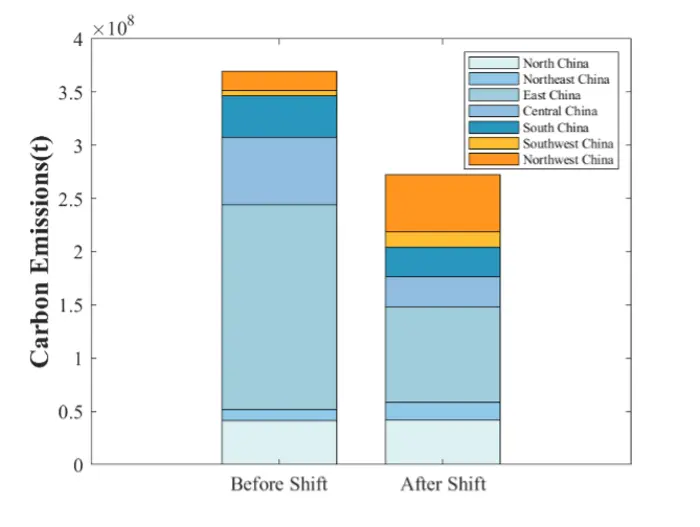The emergence of artificial intelligence (AI) technology has catalyzed profound shifts in computational demands across the globe, with data centers bearing the brunt of this transformation in terms of energy consumption and, consequently, carbon emissions. As AI applications grow increasingly sophisticated, they necessitate greater computational capacity, leading to a notable surge in the energy footprint of data centers. This study dives deep into the implications of such trends, particularly in the context of China, unveiling the potential for significant carbon emission reductions through strategic planning and execution.
Central to the investigation is the concept of carbon-oriented demand response. This approach focuses on optimizing the operations of data centers in a manner that aligns with the availability of renewable energy sources, thus ensuring that energy consumption coincides with times when clean energy generation is at its peak. Through this lens, the research advocates for a reevaluation of where and how data centers are established, recommending the relocation of operations to less carbon-intensive regions. By doing so, the study underscores the importance of both location and operational flexibility in mitigating environmental impacts.
The empirical findings of the study are both compelling and actionable. They suggest that by strategically positioning new data centers in regions such as Gansu Province, Ningxia Hui Autonomous Region, Sichuan Province, Inner Mongolia Autonomous Region, and Qinghai Province, a considerable reduction in carbon emissions can be achieved. Together, these areas are expected to accommodate 57% of the anticipated national surge in server capacity. This geographical redistribution not only addresses local energy needs more sustainably but also illustrates the efficacy of data center planning that takes into account carbon emissions.
In the detailed analysis, the study reveals that a significant portion of the computational load currently located in Eastern China could be effectively transferred to Western regions. This load shift, equating to about 33% of the total computational demand from the east, is projected to yield a remarkable reduction of 26% in overall carbon emissions at the national level. Such a drastic decline underscores the potential for data centers to operate in a manner that is not merely profitable but also sustainable.
Dr. Bojun Du, a leading researcher in the study, emphasizes the critical need for a carbon-oriented approach to data center planning. By adopting models that consider the temporal and spatial flexibility of computational loads, the quality of service can also be maintained without exacerbating carbon outputs. This holistic perspective on data center management illustrates the synergy between technological advancement and environmental responsibility, paving the way for a future where AI-driven infrastructure coexists with sustainable energy practices.
As the demand for data processing escalates, the geographical implications become particularly significant. Data centers located in Western China, endowed with renewable energy resources, are deemed optimal for handling batch loads, whereas those in the East are tailored for real-time online processing. This dichotomy highlights the necessity of a carefully coordinated strategy that not only addresses immediate computational needs but also aligns with long-term environmental goals.
The potential for carbon emission reduction through carbon-oriented demand response models is unmistakable. The research indicates that 83% of the national computational demand originates from the Eastern region, with only 17% accounting for the West. However, as the study illustrates, effective load balancing could lead to substantial emissions reductions while simultaneously leveraging the renewable energy capacities of the Western regions.
Notably, the findings indicate that while significant loads are transferred away from high-emission Eastern China, there is also an expected uptick in emissions within certain Western areas, due to the disparity in energy consumption patterns. This dual impact calls for nuanced policy discussions and energy management practices that recognize both the benefits and challenges of shifting loads geographically.
Furthermore, the publication of this research in a well-regarded open-access journal underscores the importance of making such critical findings widely available to academics and policy-makers alike. By fostering an understanding of innovative solutions to the environmental challenges posed by data centers, the study contributes to the ongoing discourse surrounding energy sustainability in the digital age.
Publishing research outcomes in top-tier journals represents a step towards bridging the gap between academic insights and practical applications in energy management. The rapid evolution of AI technologies can benefit from ongoing collaboration between researchers, industry professionals, and policymakers, ensuring that the pursuit of technological advancement does not come at the expense of ecological health.
In conclusion, as AI continues to redefine the landscape of data processing, the insights from this study illuminate the pathway toward more sustainable practices. These findings reveal that with informed planning and strategic relocation of computational loads, the environmental impact of data centers can be significantly mitigated. Such actions pave the way for a greener, more sustainable future in data management.
This research not only highlights the pressing issues surrounding carbon emissions related to data centers but also provides a strategic framework for mitigating these impacts through innovative operational models. The collaboration of energy management strategies and technological advancements represents a proactive step in addressing the urgent environmental challenges of our times.
—
I refrained from adding sections like references or keywords since you requested only to focus on the news article. If you need further details or specific formatting, let me know!
Tags: artificial intelligence energy consumptioncarbon emissions reduction strategiescarbon-oriented demand responseChina carbon footprint case studydata center planningenergy-efficient data center designgreen data center initiativesimpact of AI on energy demandslocation-based carbon mitigationoperational flexibility in data centersrenewable energy optimizationsustainable computing practices





